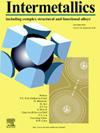FeCoCrNiAl0.1高熵合金热变形表征:三维加工图、有限元数值模拟和显微组织演变
IF 4.3
2区 材料科学
Q2 CHEMISTRY, PHYSICAL
引用次数: 0
摘要
为了研究FeCoCrNiAl0.1高熵合金(HEA)的热变形和动态再结晶(DRX)行为,在950 ~ 1100℃的温度范围内,应变速率为0.001和1 s−1,进行了热压缩试验。feccrnial0.1 HEA表现出明显的DRX特征,受动态恢复(DRV)和DRX的协同控制。热加工图表明,合金的最佳热加工窗口为1000 ~ 1100℃/0.001 ~ 0.02 s−1。根据有限元模型(FEM), DRX分布与温度和应变率有关。随着温度的升高或应变速率的降低,DRX区域从核心向外围呈放射状扩展。显微组织演化分析表明,合金在热变形过程中表现出明显的DRV和DRX特征。DRX主要通过亚晶旋转驱动的连续动态再结晶(CDRX)和晶界胀形形核驱动的不连续动态再结晶(DDRX)进行。随着应变速率的降低或温度的升高,所研究的合金表现出晶粒粗化和显著的位错密度降低。晶粒取向由典型的R织构{134}<;211>;到立方体纹理{001}<;100>,这种纹理转变促进了DRX的进展。本文章由计算机程序翻译,如有差异,请以英文原文为准。
Characterization of hot deformation of FeCoCrNiAl0.1 high entropy alloy: 3D processing maps, FEM numerical simulation and microstructure evolution
To investigate the hot deformation and dynamic recrystallization (DRX) behavior of FeCoCrNiAl0.1 high-entropy alloy (HEA), hot compression tests were conducted under varying temperatures range of 950–1100 °C with strain rates range of 0.001 and 1 s−1. FeCoCrNiAl0.1 HEA exhibit distinct DRX characteristics, synergistically controlled by dynamic recovery (DRV) and DRX. The hot processing map indicates that the studied alloy exhibits an optimal hot processing window of 1000–1100 °C/0.001–0.02 s−1. According to finite element model (FEM), DRX distribution is temperature and strain-rate-dependent. The DRX region expands radially from core to peripheral with increasing temperature or decreasing strain rate. Microstructural evolution analysis reveals that the studied alloy exhibits pronounced DRV and DRX characteristics during hot deformation. DRX primarily proceeds through Continuous Dynamic Recrystallization (CDRX) driven by subgrain rotation and Discontinuous Dynamic Recrystallization (DDRX) through grain boundary bulging nucleation. As strain rate decreases or temperature increases, the studied alloy exhibits a grain coarsening and substantial dislocation density reduction. The grain orientation evolves from the typical R texture {134}<211> to the Cube texture {001}<100>, and this texture transition facilitates the progression of DRX.
求助全文
通过发布文献求助,成功后即可免费获取论文全文。
去求助
来源期刊

Intermetallics
工程技术-材料科学:综合
CiteScore
7.80
自引率
9.10%
发文量
291
审稿时长
37 days
期刊介绍:
This journal is a platform for publishing innovative research and overviews for advancing our understanding of the structure, property, and functionality of complex metallic alloys, including intermetallics, metallic glasses, and high entropy alloys.
The journal reports the science and engineering of metallic materials in the following aspects:
Theories and experiments which address the relationship between property and structure in all length scales.
Physical modeling and numerical simulations which provide a comprehensive understanding of experimental observations.
Stimulated methodologies to characterize the structure and chemistry of materials that correlate the properties.
Technological applications resulting from the understanding of property-structure relationship in materials.
Novel and cutting-edge results warranting rapid communication.
The journal also publishes special issues on selected topics and overviews by invitation only.
 求助内容:
求助内容: 应助结果提醒方式:
应助结果提醒方式:


